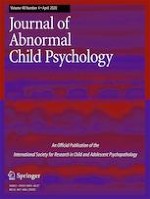18-12-2019
Differences in Parent and Child Report on the Screen for Child Anxiety-Related Emotional Disorders (SCARED): Implications for Investigations of Social Anxiety in Adolescents
Gepubliceerd in: Research on Child and Adolescent Psychopathology | Uitgave 4/2020
Log in om toegang te krijgenAbstract
Social anxiety typically emerges by adolescence and is one of the most common anxiety disorders. Many clinicians and researchers utilize the Screen for Child Anxiety Related Disorders (SCARED) to quantify anxiety symptoms, including social anxiety, throughout childhood and adolescence. The SCARED can be administered to both children and their parents, though reports from each informant tend to only moderately correlate. Here, we investigated parent–child concordance on the SCARED in a sample of adolescents (N = 360, Mage = 13.2) using a multi-trait multi-method (MTMM) model. Next, in a selected sample of the adolescents, we explored relations among child report, parent report, and latent social anxiety scores with two laboratory tasks known to elicit signs of social anxiety in the presence of unfamiliar peers: a speech task and a “Get to Know You” task. Findings reveal differences in variance of the SCARED accounted for by parent and child report. Parent report of social anxiety is a better predictor of anxiety signs elicited by a structured speech task, whereas child report of social anxiety is a better predictor of anxiety signs during the naturalistic conversation with unfamiliar peers. Moreover, while latent social anxiety scores predict both observed anxiety measures, parent report more closely resembles latent scores in relation to the speech task, whereas child report functions more similarly to latent scores in relation to the peer conversation. Thus, while latent scores relate to either observed anxiety measure, parent and child report on the SCARED each provide valuable information that differentially relate to naturalistic social anxiety-related behaviors.
